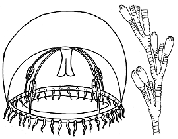RAMS taxon details
Phialellidae Russell, 1953
1612 (urn:lsid:marinespecies.org:taxname:1612)
accepted
Family
- Genus Phialella Browne, 1902
marine, brackish, terrestrial
Russell, F.S., 1953. The medusae of the British Isles. Anthomedusae, Leptomedusae, Limnomedusae, Trachymedusae and Narcomedusae. : 1-530, pls. 1-35.
page(s): 314 [details] Available for editors
page(s): 314 [details] Available for editors
Schuchert, P.; Choong, H.; Galea, H.; Hoeksema, B.; Lindsay, D.; Manko, M.; Pica, D. (2025). World Hydrozoa Database. Phialellidae Russell, 1953. Accessed through: De Broyer, C.; Clarke, A.; Koubbi, P.; Pakhomov, E.; Scott, F.; Vanden Berghe, E. and Danis, B. (Eds.) (2025) Register of Antarctic Marine Species at: https://www.marinespecies.org/RAMS/aphia.php?p=taxdetails&id=1612 on 2025-07-15
De Broyer, C.; Clarke, A.; Koubbi, P.; Pakhomov, E.; Scott, F.; Vanden Berghe, E. and Danis, B. (Eds.) (2025). Register of Antarctic Marine Species. Phialellidae Russell, 1953. Accessed at: https://www.marinespecies.org/rams./aphia.php?p=taxdetails&id=1612 on 2025-07-15
Date
action
by
2004-12-21 15:54:05Z
created
db_admin
original description
Russell, F.S., 1953. The medusae of the British Isles. Anthomedusae, Leptomedusae, Limnomedusae, Trachymedusae and Narcomedusae. : 1-530, pls. 1-35.
page(s): 314 [details] Available for editors
context source (Hexacorallia) Fautin, Daphne G. (2013). Hexacorallians of the World. (look up in IMIS) [details]
basis of record Bouillon, J.; Boero, F. (2000). Synopsis of the families and genera of the Hydromedusae of the world, with a list of the worldwide species. <i>Thalassia Salent. 24</i>: 47-296 (look up in IMIS) [details]
page(s): 314 [details] Available for editors
context source (Hexacorallia) Fautin, Daphne G. (2013). Hexacorallians of the World. (look up in IMIS) [details]
basis of record Bouillon, J.; Boero, F. (2000). Synopsis of the families and genera of the Hydromedusae of the world, with a list of the worldwide species. <i>Thalassia Salent. 24</i>: 47-296 (look up in IMIS) [details]

